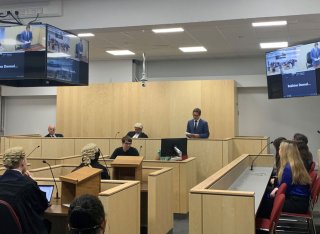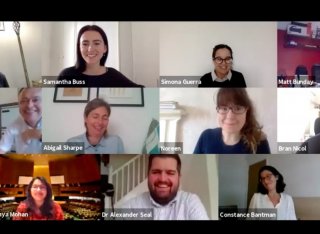
About
Biography
I joined the Department of Sociology in January 2013 and prior to that I worked and studied at the University of Leicester.
I'm on the Board of the International Network for Hate Studies and on the Steering Committee of the British Society of Criminology Hate Crime Network. I frequently work with the Sophie Lancaster Foundation and with a range of local prisons including HMP Send, HMP Coldingley and HMYOI Feltham. I'm a member of the British Society of Criminology, the European Society of Criminology and the Howard League for Penal Reform. I've been the external examiner for 14 doctoral theses in the areas of hate crime, rural racism, racism in sport and football disorder. I have supervised a number of research students through to completion.
News
ResearchResearch interests
My main areas of research are in the fields of hate crime, prisons, policing, the far-right, community and identity, and victimisation. I've been involved in many projects in these areas, the most recent being the ESRC-funded project 'Food in Prison – Doing Porridge' and the British Academy-funded 'Food, Families and Visiting Rooms in a Women’s Prison' with colleagues Maria Adams and Dan McCarthy, as well as Vicki Harman (University of Reading) and Erin Power (Liverpool John Moores).
I’ve recently been involved in an examination of the profile of hate crime reoffenders and also the impact of hate crime on victims (both with Ian Brunton-Smith (Surrey) and Darrick Jolliffe (UCL)). I’ve also just completed an evaluation of the Positive Futures police-community engagement project. Prior to that I was involved in some research which examined the impact of injuries suffered by police officers on duty, funded by the Police Dependants' Trust. Before that, I was co-investigator on the Leicester Hate Crime Project, the largest study of hate crime victimisation ever undertaken. The findings were summarised in a series of reports and academic journal articles, available The Leicester Hate Crime Project | The Centre for Hate Studies | University of Leicester.
Prior to the Leicester Hate Crime Project I have been awarded research grants from the Home Office (to evaluate police diversity training); Leicester City Council (to conduct an audit of the local African Caribbean community); the European Union (to examine the issue of racism in football); and Greater Manchester Police (to evaluate police diversity training). I have also undertaken a number of projects examining the issue of rural racism, funded by three rural constabularies (Suffolk, Northamptonshire and Warwickshire) and associated partners.
I have published seven books: Hate Crime Perpetrators: New Perspectives from Theory, Research and Practice (vols 1 & 2) (with Irene Zempi and Jo Smith); Racism and Anti-racism in Football (with Mike Rowe); The Future of Football (with Mike Rowe and Dominic Malcolm), Youth Culture, Popular Music and the End of 'Consensus' (with the Subcultures Network), and (all with Neil Chakraborti) Rural Racism, Responding to Hate Crime: The Case for Connecting Policy and Research, and Hate Crime: Impact, Causes, and Consequences. I have also had numerous journal articles and reports published on issues of hate crime, prisons, racism, community safety, policing, cultural criminology, and identity.
Research interests
My main areas of research are in the fields of hate crime, prisons, policing, the far-right, community and identity, and victimisation. I've been involved in many projects in these areas, the most recent being the ESRC-funded project 'Food in Prison – Doing Porridge' and the British Academy-funded 'Food, Families and Visiting Rooms in a Women’s Prison' with colleagues Maria Adams and Dan McCarthy, as well as Vicki Harman (University of Reading) and Erin Power (Liverpool John Moores).
I’ve recently been involved in an examination of the profile of hate crime reoffenders and also the impact of hate crime on victims (both with Ian Brunton-Smith (Surrey) and Darrick Jolliffe (UCL)). I’ve also just completed an evaluation of the Positive Futures police-community engagement project. Prior to that I was involved in some research which examined the impact of injuries suffered by police officers on duty, funded by the Police Dependants' Trust. Before that, I was co-investigator on the Leicester Hate Crime Project, the largest study of hate crime victimisation ever undertaken. The findings were summarised in a series of reports and academic journal articles, available The Leicester Hate Crime Project | The Centre for Hate Studies | University of Leicester.
Prior to the Leicester Hate Crime Project I have been awarded research grants from the Home Office (to evaluate police diversity training); Leicester City Council (to conduct an audit of the local African Caribbean community); the European Union (to examine the issue of racism in football); and Greater Manchester Police (to evaluate police diversity training). I have also undertaken a number of projects examining the issue of rural racism, funded by three rural constabularies (Suffolk, Northamptonshire and Warwickshire) and associated partners.
I have published seven books: Hate Crime Perpetrators: New Perspectives from Theory, Research and Practice (vols 1 & 2) (with Irene Zempi and Jo Smith); Racism and Anti-racism in Football (with Mike Rowe); The Future of Football (with Mike Rowe and Dominic Malcolm), Youth Culture, Popular Music and the End of 'Consensus' (with the Subcultures Network), and (all with Neil Chakraborti) Rural Racism, Responding to Hate Crime: The Case for Connecting Policy and Research, and Hate Crime: Impact, Causes, and Consequences. I have also had numerous journal articles and reports published on issues of hate crime, prisons, racism, community safety, policing, cultural criminology, and identity.
Teaching
Current Teaching and Supervision
- Becoming a Criminologist (level four undergraduate)
- Hate Crime (level six undergraduate)
- Victims & Victimology (level six undergraduate)
- Dissertation supervision (undergraduate and postgraduate)
I am interested in supervising PhDs in the areas of hate crime, victimology, prisons, policing, public order, the far-right, and football. For more more details about our PhD programme, please go to: https://www.surrey.ac.uk/department-sociology/study/postgraduate-research
Publications
Prison visits are important opportunities for those incarcerated to see their family members and maintain and strengthen family relationships. However, prison visits can be experienced as a stressful environment where family members lack control. This paper advances understandings of the prison visiting room as a space for foodcare – one that presents opportunities for incarcerated women and their family members to ‘re-do’ family by demonstrating care through food choices. Consuming refreshments together and purchasing items that would ‘treat’ incarcerated family members helped to evoke memories of eating together in childhood or prior to incarceration. The qualitative data from incarcerated women in a prison in England and their visiting family members documented how restrictions brought in concerning refreshments in the Covid-19 pandemic temporarily eliminated opportunities for family foodcare. Furthermore, when refreshments were re-introduced in a limited way, they were interpreted negatively due to an assumption that their pre-packaged nature meant they were lacking care, simultaneously demonstrating the social and familial importance of refreshments within the space of the prison visiting room
Prison is a space of deprivation of liberty with multiple ‘pains of imprisonment’ inflicted on those serving time. One component of the prison experience seldom discussed is the impact of food, particularly the ways in which food communicates broader issues about penal legitimacy. Penal legitimacy – how the penal regime operates in ways which command authority and willingness to comply – has been understood through a multitude of prison regime elements, but rarely in the context of food. We reflect on the outcomes of these experiences and perceptions of food from the perspectives of women in prison, highlighting how these perceptions can impact on the legitimacy of the prison establishment and overall quality of life in prison. Data is drawn from fieldwork in four women's prisons in England, comprising 108 study participants.
‘Positive Futures’ is a project that was designed to develop engagement and trust between the young people and the police. This was to be achieved through empowering young people to develop and deliver strategies and interventions to prevent low level crime and disorder in the communities in which they live. The project originally aimed to test two broad hypotheses: (1) that engaging the community and young people to identify and then proactively solve problems will lead to sustained, efficient, and effective solutions and (2) that properly understanding, listening, and reacting to what young people tell the police, will positively impact upon their perceptions of the police in both the short and long term.The project aimed to engage cohorts of young people (aged broadly between 11 and 15 years old) living in different communities in the county of Surrey where there were thought to be issues related to trust in the police and low-level crime problems. Local schools, the police service, youth clubs and other organisations would communicate with young people, enabling them to analyse problems, and to devise solutions to them.The project was piloted in Sunbury-on-Thames, Woking and Tadworth. Overall, while all three pilots had issues with delivering their projects to completion, they all had some successes, not least with making discernible changes to an underpass (Sunbury) and a local park (Woking) that the young people had identified as being problems that needed addressing. While less tangible progress was made in Tadworth there were still some achievements, such as the planting of additional plants and shrubs near the youth club. The involvement of the young people in all three pilots was viewed by them, and by stakeholders, as being a positive and rewarding experience, which is a significant achievement for Positive Futures too.
An illustrated collection of recipes and advice based around the experiences of women separated from their families by imprisonment. Beyond Porridge engages with creativity, social interactions and diversity within prison walls. The book explains how women in prison use limited ingredients to supplement their standard prison diet and enjoy a 'minor feast'. It tells of the comfort foods they miss most. In their own words and illustrations the book shows how ingenuity can spring from the most unlikely of circumstances.The book is based on a project led by researchers at the University of Surrey. It introduces readers to Chocolate Pudding in a Mug, a quick version of Callaloo prepared in a prison cell, Mackerel Curry, Pumpkin Seed Fry, Oreo Cheesecake and Kettle Chow Mein.
This toolkit is designed for prison governors and staff to improve the quality of food. It will help those involved in the preparation and production of food in women’s prisons to reflect on existing practices and to identify ways forward to improve the relationship between women and food in prison. The material in the toolkit is drawn from ESRC- and British Academy/Leverhulme-funded qualitative studies that focused on the role of food in women’s prisons. It has been devised in partnership with His Majesty’s Prison and Probation Service and charitable organisations including Women in Prison, Food Behind Bars, Food Matters and PACT.
There is substantial literature on the importance of food in family life, but much less on women who are incarcerated and who therefore have limited opportunities to eat with their families. The space of the visiting room offers one opportunity, albeit restricted in time and space, to do this, as well as making the visit more enjoyable for family members who have often travelled long distances to see their loved one (Comfort, 2008; Jardine, 2019; Adams, 2022). In this chapter, we will examine how we can integrate the concepts of eating with the family and prison to contribute to the dialogue on passing the time. We will develop the notion of "Doing Commensality" to understand the relationship between how women in prison and their families experience meaningful eating practices in the prison visiting room and beyond. Furthermore, we will explore whether these types of eating practices can be a means to reunite and to strengthen familial bonds. The aims of this chapter will include: (1) to explore the importance of food practices that are adopted in the confinement of the prison visiting room and the home; (2) to identify good practice and challenges of eating together in the prison visiting room of women incarcerated and their families; and lastly to see how the pandemic affected food practices in the prison visiting room. This knowledge and understanding of the importance of having the opportunity to eat together in the visiting room will contribute to policy and practical recommendations to improve the quality and provision of food in a family-friendly environment, to benefit those incarcerated and those visiting.
THRIVE (Threat, Harm, Risk, Investigation, Vulnerability, and Engagement) represents a decision-making framework introduced by the United Kingdom’s (UK) National Police Chiefs’ Council in 2017, with a particular focus on vulnerability. Alongside THRIVE other intelligence-led policingmodels such as the NationalIntelligence Model (NIM),have become integralto policing practices. While THRIVE is widely adoptedas a primary analysis and decision-making framework in UK police services,its examination remainslimited, including its impact on the NIM and its use by intelligence personnel. Interviews with 15 police personnelfrom operation intelligence units within a specific English service were conducted to ascertain its level of adoption.A series of Freedom of Information (FOI) requests to all 43 UK police services in England and Wales were then initiated, to understand if the THRIVE model is adopted and, if so, where within their respective units. The findings indicate widespread acceptance and integration of THRIVE among intelligence practitioners, without immediate adverseeffects on the application of the NIM. The use of heuristic naturalistic decision-making processes in THRIVE assessments, suggestsa need for further research.Though, there is a risk of reduced decision-making capacity among frontline intelligence workersusing THRIVE within the constraints of the NIM.
The last 20 years have witnessed a growth in the recognition of the profound negative impacts of hate crime. As a result, many criminal justice systems have adopted sentencing approaches that hold the perpetrator accountable for the additional harm these offences cause to victims. While this added sentencing penalty may be supported through a retributive lens, and the wider ‘signalling’ element of these offences, there is comparatively little robust empirical evidence which demonstrates that hate crimes hurt victims more than similar non-hate crimes. This lack of evidence leaves open the possibility that the harms of hate crime could be challenged and the sentencing approaches threatened. Using 8 years (2012/13-2019/20) of the nationally representative Crime Survey for England and Wales, hierarchical linear modelling was used to disentangle the unique emotional impact of hate-motivated violence (from non-hate-motivated violence) and hate-motivated vandalism (from non-hate-motivated vandalism). The results support the notion that hate hurts more, particularly for racist and homophobic violence and gender and disability-related vandalism. However, victims of religiously motivated vandalism did not report greater emotional impacts than those who experienced non-religiously motivated vandalism. The limitations and implications of these unique results are discussed.
This paper aims to explore how staff members in women's prisons understand their role in relation to the food practices. Given the budgetary restrictions, staff shortages and overall concerns around the quality of food in prison, there is a critical gap in engaging with these staff perspectives which urgently needs addressing. Drawing on a qualitative study conducted in four women's prisons in England, this paper will explore the food practices in prison from a range of staff (n = 10). The paper focuses on the following themes: (i) understanding the different ways in which staff navigate structural issues in serving food practices; (ii) examining how staff manage the expectations of women in prison around food; (iii) analysing how they link food practices to notion of normality; and (iv) exploring the ways in which staff navigate the debates on whether food should be seen as a form of punishment or rehabilitation.
This article identifies discourses which serve to 'normalise' experiences of anti-LGBT (Lesbian, Gay, Bisexual and Transgender) violence and prevent harmed LGBT persons from accessing the status of 'hate crime victim'. The phenomenon of normalisation is established in research addressing homophobic, biphobic and transphobic violence, where it is understood fundamentally as the rendering unremarkable of violent manifestations of hate due to their ubiquity. This article interrogates the dynamics of the normalisation process. Drawing on a Foucauldian approach, we explore normalisation as a disciplinary practice, through which people who have experienced anti-LGBT violence are denied access to the status of hate crime victim. Through discourse analysis of focus group data, we identify obstacles to identification and self-identification as a victim grounded in the experience and anticipation of judgement both within society and the LGBT community. Discourses against which the claims of LGBT people are adjudicated (re)produce cultural myths about hate crime, about anti-LGBT violence and about victimhood. While this article acknowledges that the value of identifying as a victim is not uncontested, it also asserts that the practice of normalisation, in denying this status, impacts on access to justice and to support. Far from passive, LGBT people who do not self-identify as victims find ways to manage the impacts of hate using their own resources. In this manner, the disciplinary practice of 'normalisation' responsibilises persons harmed by social ills for their own care and silences potentially disruptive claims of victimhood on the part of marginal people.
This article provides an analysis of the ‘affordances’ and ‘constraints’ of technology-mediated police-community engagement in the United Kingdom (UK). Whilst there has been optimism that social media may transform police communicative practice and help democratise policing, studies suggest that this potential has yet to be realised. Drawing on in-depth interviews with communications professionals, the article demonstrates that social media may afford constabularies visibility, editability, and association. However, organisational, individual and technological factors influence whether these affordances are achieved. This article adds to the literature by demonstrating how citizen engagement with mediated communication is not inevitable. It is instead a product of what the technology affords, the relationship between the technology and its users, and the context within which it is used.
Body-worn cameras (BWCs) are widely used across the public and private sectors, including in law enforcement, education, and transport. An extensive body of work exists on the use of BWCs by the public police and their impacts on officers and citizens' behaviours. In contrast, literature on the use of BWCs use in private security is very limited. Even more so is research on the use of BWCs by private security on university campuses. Drawing on semi-structured interviews with campus security officers and senior management in a university in the United Kingdom (UK), this paper investigates how and why BWCs were initially introduced, how they are used and with what outcomes. We find that adoption of the cameras was to strengthen the professionalism and credibility of officers and their ability to collect evidence. In practice, camera use is infrequent and concentrated on specific days and times of the week. BWC footage is prominently used in the investigation of alleged violations of university regulations, and it has become a tool to hold students accountable for their behaviour in a way that was not possible before the adoption of the cameras. The study offers an important contribution to our understanding of the operation and outcomes of private security on university campuses and, more specifically, the role of BWCs in these.
The operation of policing services on university campuses in the United Kingdom is under-researched. Drawing on interviews with university managers, security personnel and residential wardens, this article adds to the limited literature on policing in educational institutions by providing a case study of the organisation and implementation of campus policing at a university in the United Kingdom. We find that the work of the security teams includes routine housekeeping and caretaking tasks across campus, maintaining adherence to university rules and regulations, enhancing student well-being and welfare and preventing and responding to crimes. Further research is needed to understand how university spaces are managed and policed across the United Kingdom and the role of private security in dealing with welfare and mental health issues on campus.
This article will assess the difficulties and misunderstandings that prevent hate crime academics and practitioners from working together more productively. It will be argued that many of these problems stem from the different occupational cultures across the two spheres, which can generate varying expectations, values and practices that exacerbate problems in working relationships. Some of these difficulties relate to differing understandings of what hate crime actually is and how to counter it. The article suggests that by gaining in-depth knowledge of each other’s working methods and outputs, perhaps by being involved in formal and informal joint projects that necessitate flexibility and the development of shared approaches, academics and practitioners can devise more nuanced interventions that deal with the harms of hate crime more effectively.
Rural issues are currently attracting unprecedented levels of interest, with the debates surrounding the future of 'traditional' rural customs and practice becoming a significant political concern. However, the problem of racism in rural areas has been largely overlooked by academics, practitioners and researchers who have sought almost exclusively to develop an understanding of racism in urban contexts. This book aims to address this oversight by examining notions of ethnic identity, 'otherness' and racist victimisation that have tended to be marginalised from traditional rural discourse.
This article examines practitioner understandings and implementation of gender-responsive support within female prisons in England and Wales in the context of a growing emphasis on effective deportation of foreign national prisoners. Drawing on a case study of female prisoners from Central and Eastern states of the European Union (EU), we argue that the aims of gender-responsivity, designed to address women's gendered vulnerabilities to support their re-entry in the UK, are pragmatically re-shaped to accommodate the uncertainty surrounding their immigration status. We show how in practice, gender-responsive support functions at best to ‘manage’ gendered needs of women who are ‘not of interest’ to immigration authorities, and at worst to legitimate exclusion by side-lining vulnerabilities of women deemed as having ‘no right to remain’ in the UK. This occurs in the context of limited access to legal redress to challenge deportation decisions, unevenly spread resources in the female prison estate, and practitioners’ occupational cultures which emphasise paternalistic valuations of female foreign national prisoners’ femininity. We locate the findings in criminological debates about ‘gendering of borders’ and conclude with a reflection on the implications for advocacy at the time of increasingly restrictive immigration controls following the UK's exit from the EU.
This article analyses the issues involved with deciding which identity groups are categorized as specific hate crime victim groups and which are not. It assesses whether theories of hate crime based around hierarchical notions of group dominance and subordination are helpful in determining which groups should be included under the hate crime 'umbrella'. Through a discussion of the victimization of disabled people, the elderly and the homeless, the article outlines key concepts - relating to community, risk, harm and vulnerability - that are central to comprehending the nature of the abuse that they suffer. It also notes the common misreading of 'low-level' targeted harassment as anti-social behaviour, and assesses the impact this has upon the development of a more in-depth understanding of the circumstances of victims. The article also highlights the problems with using collective terms like 'communities' or 'groups' in this context, as such entities can be very diverse - indeed 'separate' groups often intersect with each other. As an alternative, it is suggested that moving the debate away from collective terminology towards an understanding of the risk of targeted victimization that individuals face would be helpful when trying to assess the circumstances of disabled people, the elderly and the homeless, who currently are still at the margins of the hate debate. © The Author(s) 2011.
This article draws on qualitative interviews to examine police officers’ experiences of transitioning to retirement in the United Kingdom, a matter that has been hitherto under researched. We find that the well-established routines and the social identity conferred by the police role are severed at retirement and the transition to retirement may be experienced as disruptive. This has implications for self-esteem, access to support, and perceptions of fairness of the organisation. However, we further argue that retirement is a multidimensional concept and experienced differently, depending on the context and circumstances in which it occurs. When officers are underprepared or retired for medical reasons, the transition was especially disruptive. The article makes important contributions to the literature on police officer social identity, well-being, and organisational justice.
This chapter is a reflexive account of the advent and development of a grassroots campaigning charity that seeks to combat prejudice directed againstthose from an alternative subculture. It contains extended abstracts from an interview with Sylvia llancaster, head of the Sophie Lancaster Foundation
Over the last few decades racism has been criminalised within English football. New offences have been created that outlaw racist abuse within stadia and there is considerable evidence that police and stewards enforce these prohibitions. In addition, formal and informal campaigns run by football authorities, clubs and supporters have created an environment where racism is now normatively unacceptable. Collectively, however, these developments represent an ambiguous progress. The ‘victory’ of antiracism is hollow because it has developed as part of a wider transformation of football into a commodified spectacle. Clashes between elite sportsmen involving racism are condemned in the context of their status as celebrities – icons who have transgressed. Other problems within the game that might be associated with racism – most obviously the continuing under-representation of Asian people as players and of all BME communities in non-playing roles – remain largely unaddressed. Where once the game was innovative and at the forefront of antiracism campaigns it now risks becoming complacent unless a broader understanding of institutional aspects of racism are addressed.
On a number of occasions throughout 2009 and 2010 violent clashes occurred between white and Asian males, anti-fascist demonstrators and the police in city centres in the United Kingdom. These disturbances involved a new organisation, the English Defence League (EDL), which claims to oppose ‘radical Islam’. This article charts the growth of the EDL and the affiliated Casuals United, and examines their motivations and ideologies. It assesses their links with football hooligan ‘firms’, and whether these links mean that the EDL has a large pool of violent ‘footsoldiers’ at its disposal, and concludes that the EDL’s Islamophobic views and provocative street army tactics mean that it poses the most serious threat to public order and community cohesion since the heyday of the National Front in the 1970s.
In recent years the European Union (EU) has witnessed rising levels of hate crime. However, although there have been a number of legislative and other policy initiatives introduced across the EU to combat such offences, these have developed in a piecemeal and sometimes half-hearted fashion. This article outlines the difficulties evident in theorizing hate crime and how these problems have been reflected in the divergent ways that hate crime legislation has developed across the EU. It argues that an approach to combating hate crime based on human rights, which is endorsed by many EU institutions, has failed to tackle the problem effectively and has resulted in the uneven protection of hate crime victim groups. By utilizing an individual rather than a group-based human rights approach, the damaging nature and effect of such ‘targeted victimization’ upon all hate crime victims can be better understood and addressed.
In recent years several events have damaged policing legitimacy in the eyes of the public in England and Wales, including the kidnap, rape and murder of Sarah Everard by a police officer serving in the Metropolitan Police Service in 2021 and the series of damning reports from investigations into police occupational cultures and working practices that followed. In addition, it is now nearly 25 years since the publication of the Macpherson Report into the police investigation of the racist murder of Stephen Lawrence which was supposed to be a watershed in the policing of diversity. It therefore seems prescient to turn attention to matters related to researching the policing of diversity once more. However, this is a particularly challenging area of police work to research. This chapter introduces readers to some key themes, considerations, and difficulties of conducting fieldwork in this area of policing. It begins with considering conceptual issues and problems and then examines the task of generating data that represents the values, attitudes, and behaviour of police staff about how they understand and implement diversity policing. Including examples from research conducted over 25 years by the authors, the chapter examines issues such as gaining access to, and trust of, police services, as well as the researcher's presentation of the self once in the field. The chapter also assesses issues relating to making the best use of official statistics and other data when researching policing diversity. It suggests that while researching the policing of diversity can be very challenging it can ultimately be rewarding to shine a light on this important area of contemporary policing.
This engaging and thought-provoking text provides an accessible introduction to the subject of hate crime. In a world where issues of hatred and prejudice are creating complex challenges for society and for governments, this book provides an articulate and insightful overview of how such issues relate to crime and criminal justice. It offers comprehensive coverage, including topics such as: •Racist hate crime •Religiously motivated hate crime •Homophobic crime •Gender and violence •Disablist hate crime The book considers the challenges involved in policing hate crime, as well as exploring the role of the media. Legislative developments are discussed throughout. Chapter summaries, case studies, a glossary, and advice on further reading all help to equip the reader with a clear understanding of this nuanced and controversial subject. Hate Crime is essential reading for students and academics in criminology and criminal justice.
This article examines the forms and impact of violence against those from alternative subcultures. It draws upon the findings from interviews and focus groups undertaken with over 60 participants from a range of alternative subcultural backgrounds, conducted as part of a broader two-year study of many different strands of targeted victimisation. The article suggests that ‘alternatives’ are subject to a wide range of harassment, from ‘low-level’ abuse such as verbal insults through to more extreme acts of violence. This can affect their physical and mental health, causing them to change the way they conduct their everyday lives. However, the article suggests that some of this victimisation forms part of ongoing conflict with a group that participants describe as ‘chavs’ that has hitherto been unacknowledged by hate crime scholars. This ‘little war’ is characterised by mutual hostility and antipathy flavoured by class antagonism that can escalate into violent confrontation.
This article considers the processes through which some police officers with mental ill-health experience stigmatisation in police organisations. Situated in the sociological framework of Goffman (1963) and in modified labelling theory (Link et al. 2004, inter alia) it draws on the findings of a qualitative study and examines the sources of stigma embedded in police work, the consequences of stigma for the labelled officer, the nature of any resistance to the application of the label, and approaches to challenging stigma within the policing context. It suggests that in order to tackle these negative attitudes constabularies must do more to address the processes of stigmatisation associated with mental ill-health at the individual and institutional levels.
The decision taken by Greater Manchester Police in 2013 to recognise attacks against members of alternative subcultures as hate crimes has reignited the debate regarding which groups are officially classified as hate crime victim groups and which are not. The case for including alternative subcultures under the hate crime rubric, and some of the key arguments against it, are debated within this chapter. We suggest that, although greater research is needed into the issue, various aspects of the victimisation of alternative subcultures appears to be comparable with that of recognised hate crime victim groups, including the frequency and nature of ‘low-’ and ‘high-level’ incidents, and their impact upon the victim and, crucially, those in their community. We also discuss some concerns about extending the concept of hate crime in this way, noting, for example, the possibility of ‘watering down’ the concept of hate crime by including groups that have not been historically marginalised in the manner that already recognised victim groups have. We also identify difficulties with defining exactly who can be categorised as ‘alternative’. We suggest that, if accepted, the inclusion of alternative subcultures may open the way for equally compelling claims from other targeted groups that do not currently fall under the hate crime umbrella which could, in turn, prompt more fundamental re-evaluations of the concept of hate crime itself.
Greater Manchester Police’s categorisation of targeted attacks on ‘alternative subculture’ members as hate crimes prompted extensive debate about whether such incidents are comparable to those of recognised hate crime groups. Hate crime experts have contributed to this debate but there is a lack of detailed empirical research on the subject. Drawing on qualitative interviews with twenty-one respondents mostly affiliated to the goth scene, this paper uncovers extensive experience of verbal harassment and, for some respondents, repeated incidents of targeted violence. The nature and impact of such experiences, we argue, bears comparison with key facets of hate crime. Such evidence informs and underlines the importance of conceptual arguments about whether hate crime can or should be extended beyond recognised minority groups.
Rural villages are often portrayed as problem-free, idyllic environments characterized by neighbourliness and cultural homogeneity. Drawing upon the growing body of research into issues of rural racism, this article challenges these prevailing notions by highlighting some of the problems associated with the increasing ethnic diversity of rural populations. The article begins by addressing the symbolic importance given to the English countryside by many of its white inhabitants, and assesses how this is related to romanticized feelings of national identity, 'localism' and narrow invocations of village 'communities'. It is argued that village space is not neutral but is instead racialized and contested, and that it is feelings of insecurity among white rural populations, exacerbated by the presence of a markedly different 'other', that results in the marginalization of minority ethnic groups from mainstream community activities. It is also suggested that these groups are often subjected to racist victimization, which can go unrecognized by local agencies. This clearly has implications for policing diversity in the rural, and the article explores ways in which the public police (and other rural agencies) could begin to develop a more nuanced understanding of the diversification of rural space and the 'othering' of outsider populations. © 2007 SAGE Publications.
This article examines factors that influence the processes and practices of crime prevention and investigation in rural areas of England. Whilst evidence shows that rural crime is a significant problem, there has been hitherto a dearth of research into how the issue is policed. Drawing on the perspectives of police personnel, this article examines the features of the rural environment and the organisation and management of police services that influence the delivery of police work in rural areas of England. Specifically, the article considers factors that influence the reporting and subsequent recording of rural crimes; how police officers understand and perceive rural crimes; how police services prioritise crimes for preventative and investigative purposes; how responsibility for investigating rural crimes is diffused across law enforcement agencies and how this can cause confusion for officers; matters related to the generation of evidence; officer understanding of the legislation regarding rural crime; the willingness of officers to undertake the investigation of rural crimes and the reluctance of some to live in the countryside; and the organisation and management of police resources in rural areas. In so doing, it sets out the reasons why the policing of rural spaces is distinctive and considers implications for police work and its outcomes.
This paper offers a reflective account of delivering art workshops in women's prisons in England, as one method in a larger, qualitative study around the role of food in prisons. We present reflections around the role of art workshops in building relationships and community between the researcher and the participants, and the participants themselves. We found that building connection through art workshops, in a hostile and challenging environment like prison, enabled us to gather richer and deeper data during the qualitive interviews that succeeded the art workshops. We propose that attention from researchers to the 'unintended consequences' can contribute to research projects which are impactful for both the participants and researchers. This paper addresses gaps in literature around the use of visual art as method in women's prisons and the role of arts-based methods in larger qualitative research projects in secure settings.
© the Editors and contributors 2004. All rights reserved.Rural issues are currently attracting unprecedented levels of interest, with the debates surrounding the future of 'traditional' rural customs and practice becoming a significant political concern. However, the problem of racism in rural areas has been largely overlooked by academics, practitioners and researchers who have sought almost exclusively to develop an understanding of racism in urban contexts. This book aims to address this oversight by examining notions of ethnic identity, 'otherness' and racist victimisation that have tended to be marginalised from traditional rural discourse.
In times of increasing pressures on the police service, looking after the well-being of its staff has never been more paramount. However, there has been little academic consideration either of the nature of organisational support for officers injured in the line of duty, nor of the implications for injured officers and constabularies. This article aims to fill this lacuna by drawing on interviews with police officers in England and Wales to examine officers’ perceptions and experiences of organisational support following injury on duty. We report that in the context of perceptions of cynical attitudes of leaders regarding injury, the organisational devolution of responsibility for recovery to the officer, and in the limited nature of the provision of interventions designed to aid recovery, injured officers described how they lacked support, were dealt with inappropriately, and were approached unsympathetically and sceptically. This left officers feeling cut off in the aftermath of injury. The article contributes to the burgeoning literature on the role of organisational justice by providing insights into why fairness judgements are important to officers. We suggest that uncertainty and anxiety in the aftermath of injury was the prism through which organisational responses to their injury were interpreted by officers and found to be wanting. Police organisations therefore need to fully understand this process as a first step in developing improved policies and practices that provide the help and support officers need when they are injured and feeling especially vulnerable.
This paper examines the significance of experiences and understandings of targeted harassment to the identities of youth subcultural participants, through case study research on goths. It does so against a context of considerable recent public discussion about the victimisation of alternative subcultures and a surprising scarcity of academic research on the subject. The analysis presented indicates that, although individual direct experiences are diverse, the spectre of harassment can form an ever-present accompaniment to subcultural life, even for those who have never been seriously targeted. As such, it forms part of what it is to be a subcultural participant and comprises significant common ground with other members. Drawing upon classic and more recent understandings of how subcultural groups respond to broader forms of outside hostility, we show how the shared experience of feeling targeted for harassment tied in with a broader subcultural discourse of being stigmatised by a perceived ‘normal’ society. The role of harassment as part of this, we argue, contributed to the strength with which subcultural identities were felt and to a positive embrace of otherness.
This article suggests that the concepts of vulnerability and ‘difference’ should be focal points of hate crime scholarship if the values at the heart of the hate crime movement are not to be diluted. By stringently associating hate crime with particular strands of victims and sets of motivations through singular constructions of identity, criminologists have created a divisive and hierarchical approach to understanding hate crime. To counter these limitations, we propose that vulnerability and ‘difference’, rather than identity and group membership alone, should be central to investigations of hate crime. These concepts would allow for a more inclusive conceptual framework enabling hitherto overlooked and vulnerable victims of targeted violence to receive the recognition they urgently need.
The murder of Sophie Lancaster in August 2007 in Lancashire, England, made national headlines, both for the brutal nature of the assault upon her and also because she had been attacked solely due to her ‘alternative’, gothic appearance. At the trial of her teenage assailants the judge surprisingly referred to the incident as a ‘hate crime’, apparently viewing the targeting of her ‘difference’ as being the key defining factor of what constitutes such a crime. This article will examine the validity of this assumption by analysing the characteristics of the assault upon Lancaster and also the nature, extent and impact of the harassment of goths and ‘alternatives’ more generally. It will assess the degree to which this type of victimisation is similar to that experienced by minority communities, such as gay, transgender, minority ethnic and disabled, who are routinely categorised, by both academics and practitioners, as being hate crime victim groups. The article will conclude that although there are inherent problems with classifying attacks upon goths as hate crimes, it may nonetheless be time to view the targeting of difference as being the most important aspect of what is, and is not, considered a hate crime.
Since the summer of 2009 in the United Kingdom there have been a number of violent clashes amongst white and south Asian males, anti-fascist demonstrators, and the police. These disturbances have centred around the activities of a new far-right grouping, the English Defence League (EDL), which claims to oppose ‘radical Islam’. This article charts the growth of the EDL and examines its motivations and ideologies. It argues that the increasing influence of this organisation reflects wider socio-economic and political processes, and in particular needs to be understood in light of the contemporary state of ‘post-politics’ in which the UK is embroiled. Drawing on our own empirical research, we argue that the growth in popularity of the EDL amongst some segments of England’s marginalised and disenfranchised white working class must be understood in the context of the failure of mainstream political discourses to reach out to these communities, who have instead turned to the EDL as an organisation through which they can vent their anger at the ‘Islamic other’ rather than at the political and financial classes that are the real source of their disadvantage.
This chapter reflects upon the contemporary state of the relationship between policy makers, practitioners and academics, and suggests that much still needs to be done before these domains, with their often very different priorities and perspectives, can work consistently well together. While a number of chapters in this volume have outlined ways in which the theoretically-driven world of academia has interacted successfully with its ‘hard-bitten’ practitioner equivalent, too often the domains have viewed each other with a degree of mutual scepticism, with neither holding the work of the other in particularly high regard. The chapter warns that unless the different domains can learn to eradicate this ‘clash of understandings’ then there is a danger that much of the work around hate crime will merely sustain a self-serving ‘industry’ which lacks the capacity to make a meaningful difference to the lives of victims of these offences.








